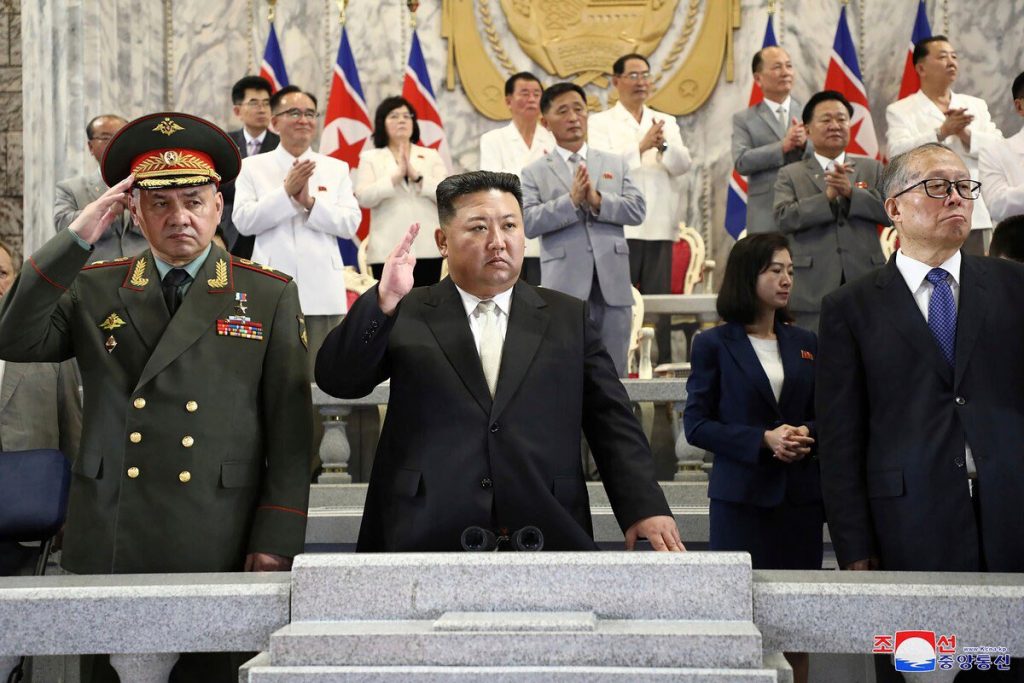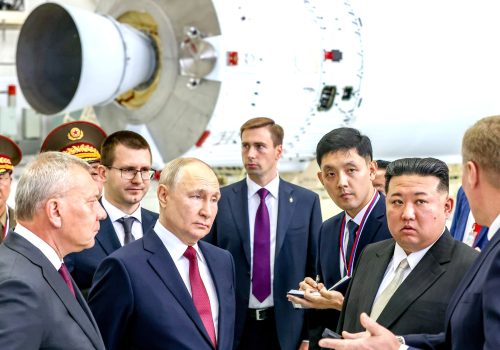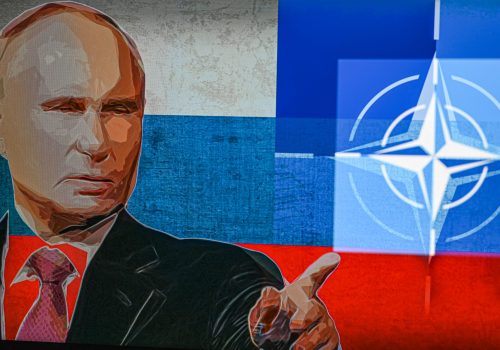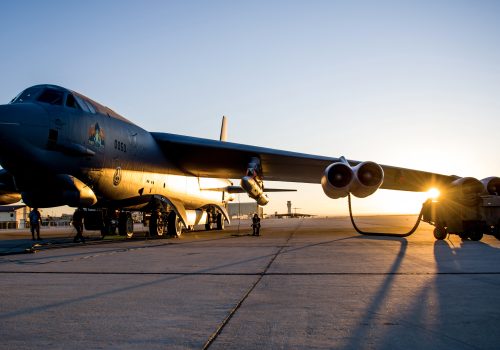It’s an explosive question. On Thursday, a bipartisan congressional commission—the first of its kind in fourteen years—said that US nuclear weapons policy is “ill-prepared” for a challenge from China and Russia. The 2023 Congressional Commission on the Strategic Posture of the United States report evaluated the threat posed to the United States by nuclear weapons and the challenge posed by China’s nuclear breakout. With China on track to deploy 1,500 nuclear warheads by 2035, making it a near-peer of the United States, what steps should the United States take to maintain deterrence and strategic stability? Our experts are here to explain the context of this major report and dive into its recommendations.
1. What are the most important recommendations from the report?
The increasing vulnerability of the United States to nuclear threats could impact the credibility of US security guarantees; therefore, lessening that vulnerability through homeland missile defenses would “assure allies and partners that the United States will not be deterred from fulfilling its global security commitments,” says the report. In other words, the United States must continue to stay ahead of the North Korean missile threat and start thinking about defenses against possible Chinese and Russian limited missile attacks for the purpose of deterring US intervention.
—Robert Soofer is a senior fellow in the Forward Defense program of the Atlantic Council’s Scowcroft Center for Strategy and Security, where he leads its Nuclear Strategy Project. Previously, he served as US deputy assistant secretary of defense for nuclear and missile defense policy.
2. What is the most provocative recommendation in the report, and is this worth pursuing?
While many foreign policy and defense experts would agree with the Commission’s recommendation to “fully and urgently execute the US nuclear modernization Program of Record (POR), which includes replacement of all US nuclear delivery systems, modernization of their warheads, comprehensive modernization of US nuclear command, control, and communications (NC3), and recapitalizing the nuclear enterprise infrastructure at the DOD and DOE/NNSA,” the recommendation will nevertheless be controversial to some readers who might see it as a sharp departure from former President Barack Obama’s famous Prague speech, in which he envisioned a world free of nuclear weapons. But the Prague speech also committed that so long as nuclear weapons remain, the United States would maintain a deterrent that was safe, secure, and effective. Today, we find ourselves in a dramatically different circumstance from 2009: China is rapidly expanding its nuclear forces, and earlier this year President Vladimir Putin announced that Russia would be suspending its participation in New START, the last remaining US-Russia arms control pact. In this world, it is even more prudent that the United States recapitalize the nuclear enterprise infrastructure for the sake of national security.
–Neil Narang is a nonresident senior fellow in the Forward Defense program.
3. Are the steps suggested in this report sufficient to address the nuclear deterrence challenges facing the United States?
The commission refers generally to a need to have numerically larger US nuclear forces in the face of projected numbers of Chinese weapons. (The introduction describes this as an issue on which the group did not agree.) Granted that numbers have some inherent significance, the standard ought to be whether the force is adequate to meet deterrence requirements—not its overall numbers. But in the tripolar environment, it remains important that the force is survivable and flexible enough—and that is not a function of how many potential targets the adversaries present.
—Walter B. Slocombe is a board director at the Atlantic Council. He served as US under secretary of defense for policy from 1994 to 2001.
The current nuclear modernization plan is necessary but insufficient for the challenges we face from China, Russia, North Korea, and potentially other nuclear powers, says the report, leading to the logical conclusion that “deployed strategic nuclear force structure requirements will increase for the United States” and “modifications to both strategic nuclear forces and theater nuclear forces are urgently necessary.” The report does not recommend specific numbers, but the additional nuclear force requirements need not be overwhelming, and will depend on just how far China will proceed with its nuclear force expansion.
—Robert Soofer
4. Was there an issue in the current report (or conspicuous by its absence) that split the commissioners?
Survivability is not just a matter of the weapons platforms but of the communications infrastructure needed to maintain the ability to control and direct the use of the force in a post-attack environment. On this the commission is largely silent—possibly because of the secrecy rightly surrounding the C4I system. But it’s a critical issue on capability to deter escalation or third party intervention.
–Walter Slocombe
5. Are these recommendations realistic? What political or other barriers do they face?
At a time when it’s difficult for Republicans and Democrats to agree on anything, it is all the more remarkable that the commissioners, representing a broad range of views, could reach such a consensus document. It should shake Washington out of its slumber: The report’s recommendations are realistic and politically viable, while recognizing the potential financial demands will place a strain on the national security budget.
—Robert Soofer
The commission calls for a wide range of new, expanded, or accelerated programs, including a conventional capability to defeat simultaneous and coordinated aggression by both China and Russia. Beyond acknowledging that implementing its recommendations will be “costly,” it says nothing about the scale or source of the massive additional funding that would be required. That makes it hard to evaluate the practicality of its recommendations as distinct from their desirability.
—Walter Slocombe
Further reading
Wed, Sep 13, 2023
What the Putin-Kim authoritarian get-together means for Russia’s war and North Korea’s capabilities
New Atlanticist By
Experts react to Russian President Vladimir Putin and North Korean leader Kim Jong Un meeting at the Vostochny Cosmodrome in Russia.
Thu, Aug 31, 2023
Putin’s Russia must not be allowed to normalize nuclear blackmail
UkraineAlert By Olivia Yanchik
Vladimir Putin has used nuclear threats to intimidate the West and reduce the flow of military aid to Ukraine. If this trend does not change, Russia will succeed in normalizing nuclear blackmail as a foreign policy tool, writes Olivia Yanchik.
Wed, Jun 14, 2023
Before embarking on arms control talks, Biden needs a nuclear deal with Congress
New Atlanticist By Robert Soofer
The White House and Congress disagree over the type and number of nuclear weapons needed to deter Russia, China, North Korea, and potentially Iran.
Image: Russian defense chief Shoigu (left) and Chinese politburo member Li (right) join Kim Jong Un on the viewing stand at the July 27, 2023 military parade in Pyongyang, North Korea. Chinese and Russian officials stood shoulder to shoulder with Kim Jong Un as they reviewed North Korea's latest nuclear-capable missiles and new attack drones at a military parade in Pyongyang, North Korean state media showed on Friday July 28, 2023. The widely anticipated parade in the capital on Thursday night commemorated the 70th anniversary of the end of the Korean War, celebrated in North Korea as Victory Day. Rodong Sinmun via EYEPRESS



